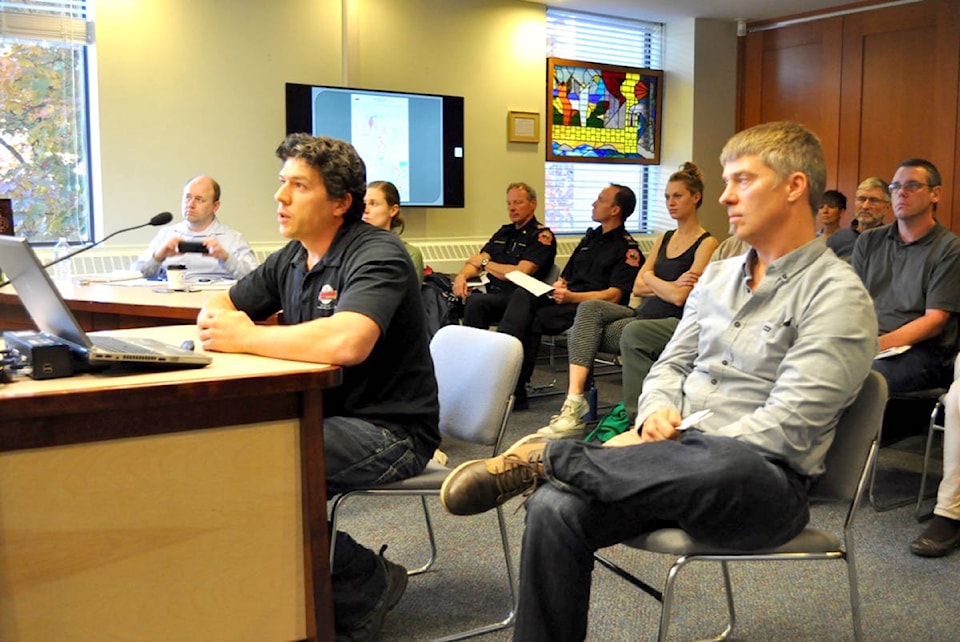A Douglas fir bark beetle infestation near one of Nelson’s water sources could lead to further outbreaks as well as potential wildfires if not addressed before next spring.
That was the red flag Kalesnikoff Lumber waved in front of city council during a presentation Monday afternoon. Development supervisor Gerald Cordeiro told council the outbreak near Selous Creek needs to be taken care of before next April when beetles begin to fly in warmer temperatures.
Selous Creek is a secondary water source for the city, often used in the summer to augment the main source, Five Mile Creek.
The beetles kill trees within one to two years, raising the possibility that the current infested area of about 400 trees within 90 hectares could become a tinder box just outside city limits.
“It’s very clear to me the main concern to the public should be the fire hazard that this could bring if left unchecked,” said Cordeiro.
“The secondary thing that people should think about is this is in their backyards and it’s a region-wide problem.
“This isn’t just in Selous, we have it in the Slocan Valley, we have it throughout the whole region. People should be looking at the hillsides and thinking about their own security from fire and the fact that they can potentially do something about it as well.”
Kalesnikoff still needs permission to log the area, which requires approval from the Ministry of Forests, Land and Natural Resource Operations.
The ministry also needs to give Kalesnikoff’s plan an exemption from current regulations that limit more than one per cent of visible landscape be altered by cutting.
A public consultation for Kalesnikoff’s forest stewardship plans for the area ended last month. Kalesnikoff hopes to be given the green light from the ministry within 40 days.
Tyler Hodgkinson, a woodlands manager for Kalesnikoff, wanted to allay fears the logging would interfere with the watershed.
“The watershed is quite fortunate in that the bugs are a lot more on that ridge line and that’s where they are concentrated as opposed to in the watershed,” said Hodgkinson. “So the actual incursion in the watershed is less than two per cent. The impact is pretty much negligible.”
A Kalesnikoff hydrological assessment of the area, which wasn’t ready in time for Monday’s meeting, is also underway.
Mayor Deb Kozak said she thinks the situation isn’t the same as in Ymir, where the community is protesting a planned cut in its watershed.
“I sensed from the Kalesnikoff company that they are being really careful in how they’re approaching this, because they know that watersheds are sensitive topics to communities,” said Kozak. “I’m looking forward to hearing that hydrological report and what they learned from it, because they are being very careful about what they are doing.”
Hodgkinson said the infestation was first discovered last summer when the company was assessing the area for wildfire mitigation with the Regional District of Central Kootenay.
The plan for the controlling the infestation involves several steps.
Trap trees, some of which were already felled in the spring, are logs that are set up on the perimeter of the contaminated area to draw in the beetles. Those trees are then milled, which kills the beetles. Baited trees outside the watershed will require clear cutting, while a controlled burn of slash will take care of beetles on the ground.
Hodgkinson said he believes the beetles come from nearby Ward Creek. Earth stability doesn’t allowed for logging in that area, but the ministry has already set up trap trees there.
The land the beetles are on is Crown land, but the removal cost will be taken on solely by Kalesnikoff. That’s something Hodgkinson isn’t happy about.
“Since [the Forest and Range Practices Act] has come in, the ministry has stepped back and let the licensees do all the work,” he said, adding private landowners also need to bear some of the responsibility.
“I’m thinking that in order to also promote professional reliance and all of us to work together, they need to step back into the game and start engaging.”
The pair said Nelson is lucky in that the bark beetles are easier to remove than other species such as the mountain pine beetle.
“We’re fortunate that we are there now and that we’re going to remove the volume of wood that is infested, so that should be able to nip it in the bud,” said Hodgkinson.
